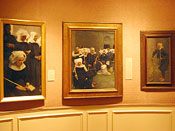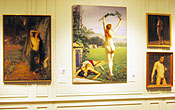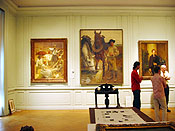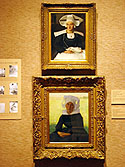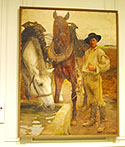The browser will either open the file, download it, or display a dialog.
|
"Against the Modern: Dagnan-Bouveret and the Transformation of the Academic Tradition" Gabriel P. Weisberg |
||||||||
|
The process of re-evaluating academic art of the nineteenth century and exploring themes important to the era has been a long and arduous one. While much work has been done on the principal academic painters of the mid-nineteenth century, such as Jean-Léon Gérôme and Adolphe-William Bouguereau, those of the last decades of the century have remained in relative obscurity, overshadowed by the impressionists and their avant-garde followers. The attempts of these later academic painters to modernize academic art have largely been ignored, while public attention frequently has been directed toward the artists linked to the modern movement who favored abstraction. |
|||||||||
| Gabriel P. Weisberg tried to accomplish something quite original in an exhibition organized by the Dahesh Museum of Art and recently shown at the National Academy of Design in New York City. The Museum and Weisberg have continued the task of unearthing the achievements of late nineteenth-century academic artists with "Against the Modern: Dagnan-Bouveret and the Transformation of the Academic Tradition." This is the first comprehensive exhibition (fig. 1) devoted to this talented painter since an abbreviated show at the Art Institute of Chicago in 1901, and the little known retrospective held at the École des Beaux-Arts in 1930, the year after the artist's death. This recent exhibition provided a fascinating glimpse into how an academic painter responded to the necessity of revitalizing tradition by assimilating the innovations of more progressive painters around him. | |||||||||
| Pascal-Adolphe-Jean Dagnan-Bouveret (1852–1929) began his studies at the École des Beaux-Arts in 1869. He entered the atelier of Jean-Léon Gérôme in 1870 and quickly became a favorite pupil and friend of his instructor. Indeed, Dagnan-Bouveret would look to Gérôme for guidance throughout much of his career. His first painting to be accepted at the Salon was the Atalanta of 1874 (Musée Municipal, Melun), which is included in the exhibition (fig. 2). After failing to win the coveted Prix de Rome in 1876, 1877, and 1878, he left the École and set out on his own. It is after this period that the range of Dagnan-Bouveret's talent and evidence of his openness to new trends began to emerge. From 1878 to 1900, the most successful and creative years of his career, he worked in a variety of styles, creating paintings that ranged from intimate portraits, still lifes, and landscapes to monumental genre scenes and moody religious compositions. He integrated new technology and methods, such as photography and plein-air painting, into the traditional academic creative process and often combined the supposedly disparate styles of naturalism and symbolism in a single painting. The results can be seen, for example, in his Madonna of the Rose (Metropolitan Museum of Art, New York) and In the Forest (Musée des Beaux-Arts, Nancy) (fig. 3). Such works were sought after by collectors around the world, and found their way to places as far flung as the United States and Russia. While his reputation declined after his induction into the Académie des Beaux-Arts in 1900, Dagnan-Bouveret, with his subtle use of innovative working methods, helped to revitalize an ailing academic system at the same time that it was being superseded by more modern approaches. | |||||||||
| The Dahesh exhibition focused on Dagnan-Bouveret's career from its beginning in 1875 until after 1900. It brought together works from museums and private collections in the United States, Canada, England, France, and Russia, some of which have been hidden from public view for years. The works were arranged chronologically—and thematically where possible—in a series of three rooms, allowing the visitor to see the artist's stylistic evolution. Extensive wall texts and a highly readable exhibition catalogue placed each work within the context of Dagnan-Bouveret's life and the art world in which he moved. The wall labels, synthesizing material in the catalogue, provide an essential context for this little-known artist. | |||||||||
|
|
|||||||||
| In addition to bringing together paintings, drawings, and watercolors by the artist, the exhibition went far in raising issues regarding the training methods of the École des Beaux-Arts and the working approaches of academic painters of the nineteenth century. The first room, which covered Dagnan-Bouveret's career from 1872 to 1887, included sketches of the artist's family and compositional drawings completed for Prix de Rome competitions. The family sketches reveal Dagnan-Bouveret's early tendency toward a naturalist aesthetic, while the Prix de Rome drawings represent the traditional preference for history painting that was instilled in young art students. These latter works, of a kind that are rarely exhibited, contribute to a better understanding of the teaching methods of the École des Beaux-Arts, and especially of how the prescribed themes could influence a young painter. The exhibition continued with a number of paintings that attest to the range of Dagnan-Bouveret's oeuvre and of the subjects open to an academic painter: history painting, with Hamlet and the Gravediggers; illustration for contemporary journals, with A Bird Charmer in the Tuileries Garden; portraiture, with the sun-lit Portrait of the Artist's Fiancée, Anne-Marie Walter; and genre, with the anecdotal Wedding at the Photographer's and the more contemplative Blessing of the Young Couple before Marriage: Custom of the Franche-Comté. Each of these works also helps make the case visually that Dagnan-Bouveret often was searching for alternative approaches as his career evolved. To make this point about an academic artist helps humanize his artistic choices. | |||||||||
| The Blessing of the Young Couple before Marriage is a stunning example of the artist's personal approach to painting. In it, a young couple, dressed in wedding attire, kneel at the feet of their parents. The elderly father holds a long candle over their heads, granting his consent. Loose rose petals are scattered in front of the kneeling couple, where a small prayer book also lies. A long dinner table, upon which is a still life of bread, glasses, and wine bottles, divides the main figures from the group of wedding guests who stand behind it. The model posing for the bride is Dagnan-Bouveret's wife, Anne-Marie, and the family members who give their consent are her parents. The painting is set in the Franche-Comté, the region of France where the artist kept a home and studio and spent much of his time away from Paris. The gauze of the bride's veil and wrinkled faces of her parents are carefully rendered, as are the soft light of the room, the bright sunlight shining in through a window and the warm glow of the candle. The painting shows Dagnan-Bouveret's preference for familiar models and modern themes, his skill as a draftsman, and his sensitivity to lighting conditions. It exemplifies the naturalistic approach for which he was known and the quiet, introspective mood that tinged many of his works. | |||||||||
| The second room of the exhibition took us from the mid-1880s and the height of Dagnan-Bouveret's naturalist style to his shift toward religious symbolism in the 1890s. The most significant works in this part of the exhibition were the numerous studies for Breton Women at a Pardon of 1887, a painting that, unfortunately, could not be obtained for the exhibition. They included a study of two Brittany women, sketched in ink, charcoal, and pastel on fragments of tracing paper that were pasted together into a sort of collage. This study, along with other drawings, an oil sketch, and copies of photographs reprinted on the wall labels, reveal the artist's painstaking method of creating suitable compositions, color harmonies, and photographic effects. They demonstrate Dagnan-Bouveret's innovative technique of integrating photography and collage into the traditional practices that he learned at the École. The studies are works of art in their own right, as beautiful as they are instructive. Taken as a group, they provide a clear plan of how an academic artist worked, arranging his forms in the most precise way, so that he could achieve, in the final painting, the look of exact photographic verisimilitude (fig. 4). | |||||||||
|
|
|||||||||
| The largest paintings of the exhibition hung in the final room and provided a summary of Dagnan-Bouveret's entire career. They included the artist's first Salon canvas, the still immature Atalanta of 1874, the more sensitive and well-drawn Salon contribution, Orpheus's Sorrow of 1876, as well as the huge Horses at the Watering Trough (Musée d'Art e d'Histoire, Chambéry; fig. 5), which earned the painter the Legion of Honor in 1885. The highlight of this room was In the Forest of 1892 (fig. 3), whose warm color and introspective mood should appeal to modern viewers. The painting portrays a rustic fiddler in a forest clearing. With arm outstretched, he plays a long, slow note on his instrument. A group of peasants surround him, mesmerized by his song as they finish a meal. Dagnan-Bouveret is at his best here, carefully rendering the facial expressions of the figures to show their silent focus on the music. The painting recalls the realism and introspective tone of Gustave Courbet's After Dinner in Ornans (1848–49; Musée des Beaux-Arts, Lille) and makes plain the urgent need for this new examination of Dagnan-Bouveret's work. It also suggests that Dagnan-Bouveret, during the early 1890s, was adept at modifying his brand of naturalism by the inclusion of an intimate symbolism based on color harmonies and mood responses. | |||||||||
| The entire exhibition was housed in comfortable rooms, the first two of which are small and intimate, which allowed the visitor to take in all of the works at once and to get close up to the small studies in oils or ink. Dagnan-Bouveret's intimist inclinations, his love of precision and detail inspired by earlier miniaturists, were well represented by the works selected. The final room, which contained the larger paintings, reiterated the imposing nature of the artist's public imagery. As a group, these works revealed the opposite tendencies an academic painter had to master: intimate images to satisfy his own tastes and those of some patrons and monumental scenes destined for large public spaces. | |||||||||
| Whether or not one sees Dagnan-Bouveret as deserving of re-evaluation, "Against the Modern" offered a unique opportunity to gain a more thorough understanding of the art and painting practices of this period as viewed through the work and career of a single artist. Through the inclusion of numerous studies and documentary photographs, it demonstrated that Dagnan-Bouveret was aware of modern tendencies and used them to breathe new life into the academic tradition at a time when it was under attack by the avant-garde and threatened with extinction. Weisberg has effectively proven that the academics could adapt to changes in the artistic climate and attract support in the face of aesthetic revolution. Moreover, the exhibition provided ample evidence that looking more closely at the work of an academic painter allows for a better understanding of an alternative tradition in the nineteenth century. Future studies in this direction should shed additional light on the modern era. | |||||||||
| Michelle C. Montgomery The Graduate Center City University of New York |
|||||||||


